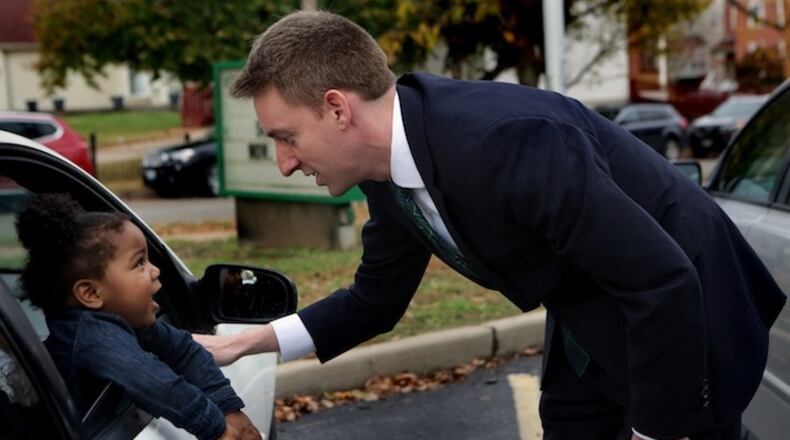Or Jason Kander, another 35-year-old considered one of the bright spots of the 2016 election despite losing his Senate race in Missouri to the Republican. This former official in a state that went to Trump by nearly 20 points has now signed a contract with CNN and formed a national voting rights advocacy group — hardly the traditional path for a politician his party needs to get ready for another race, but he didn't have much choice.
"One of the unheralded but critically important trends of the last several election cycles has been an increasing correlation between presidential voting and voting for Senate and Congress and even governor," said Mark Mellman, a top Democratic pollster. "It is harder for Republicans to win in blue states and harder for Democrats to win in red states than it used to be."
Kander and Buttigieg are the two Democrats mentioned most often by party elders as rising stars trapped in tough states. But the list also includes young leaders such as Adam Edelen, Kentucky's former auditor of public accounts, and Julian and Joaquin Castro, the former secretary of housing and urban development and congressman from Texas, respectively.
Joaquin Castro is considering a campaign next year against Sen. Ted Cruz, R-Texas, an effort most political analysts consider a long shot in a state that hasn't elected a Democrat to statewide office in more than two decades.
Leading party strategists say a failure to elect Democrats in red states would put more at stake than just the pipeline of future leaders. The party risks alienating key swaths of voters in red and rural states if its leaders hail only from blue America, the very problem that confronted Hillary Clinton during last year's presidential campaign.
"Honestly, if those voices had been paid more heed in the last election, perhaps the outcome would have been different," said David Axelrod, who served as a senior adviser to President Barack Obama. "Because I think they understand the voters in their states and localities and saw the Trump thing from the ground up."
To the extent Democrats have a plan to win in these states, it rests mostly on Trump's shoulders. Party strategists are hopeful that a backlash to the White House incumbent, whether in the 2018 midterm or 2020 presidential elections, will give Democratic candidates a chance to win in all but the reddest of states.
There's a recent precedent for their optimism: Republicans were able to win Senate and gubernatorial races in 2010 in states like Pennsylvania, Wisconsin and Michigan — all places Obama had won easily in 2008.
"It's very hard to predict today what the political landscape is going to look like two and four and six years from now," Axelrod said. "Nobody would have predicted two years before the 2008 election that Barack Obama would have been elected president and carried the state of Indiana, which hadn't been carried by a Democrat since 1964."
But he conceded that states Trump won might be more resistant to changing back. Obama won Pennsylvania in 2008, for instance, by 10 points. Trump nearly doubled that margin last year in Indian and Missouri.
"Winning in states of the opposite party is increasingly difficult," Mellman said. "It's not impossible, people have certainly done it, but it's a difficult thing to do."
Democrats expect Kander will run again, noting that he lost last year's Senate race by just 3 points. To them, his margin of defeat was evidence that he could just as easily win a statewide race in Missouri in a political environment that's even slightly more favorable for the party.
What job he would seek isn't clear, however. Missouri's Senate race in 2018 features an incumbent member of his own party, Claire McCaskill. The state's governor, Eric Greitens, doesn't face re-election in 2020.
In an interview, Kander said he was focusing on his voting rights group, Let America Vote, and wasn't "thinking about the next office."
"What I'm doing with Let America Vote is really important," Kander said. "I feel really strongly about it. That's where I'm going to put my focus."
Buttigieg's term as mayor lasts until 2019, so he has time to decide what he wants to do next.
"The good news is time is on my side and I have a really fulfilling job," he told McClatchy. "It's not something I'm terribly preoccupied with."
Next year, he'll help Sen. Joe Donnelly, D-Ind., win re-election in a race Republicans consider one of their best pickup opportunities of the 2018 midterm elections. The campaign will be a test of whether a Trump-inspired backlash can help Democrats win in conservative states.
Buttigieg said it was not "written in stone" that a Democrat couldn't win in Indiana — but he cautioned that it's not going to automatically flip either.
"It's very early to tell," Buttigieg said. "I don't think we can simply assume that because Trump has offended a lot of people that he's going to lose a state like Indiana."
About the Author
